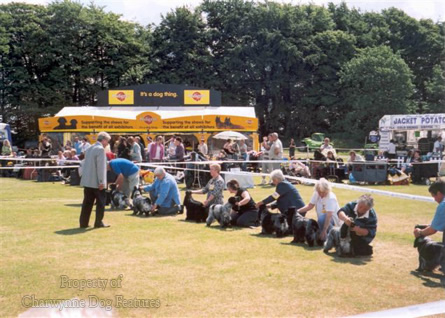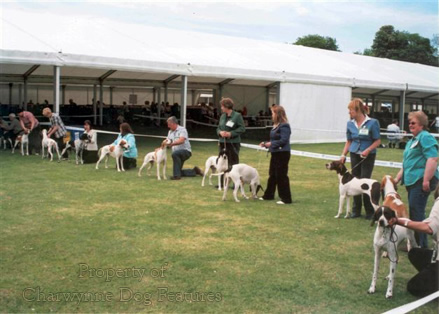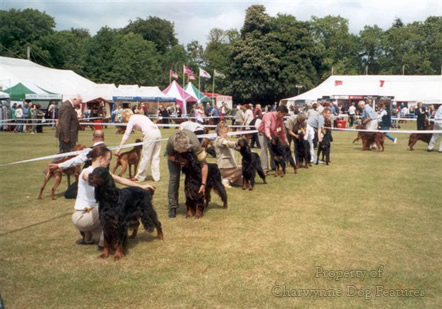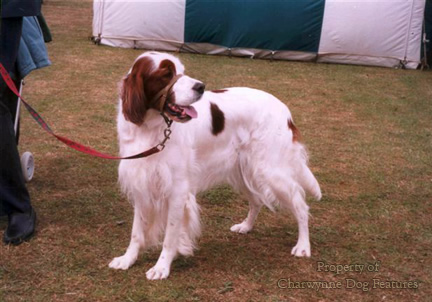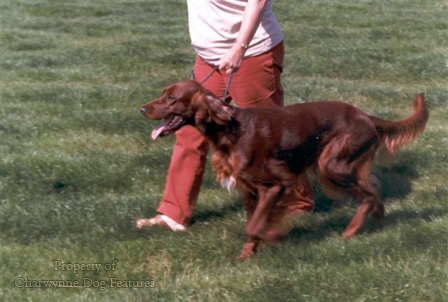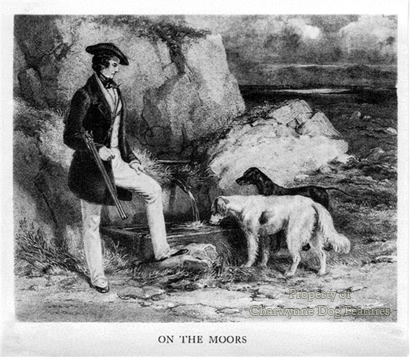167 Gundogs in Show Ring
GUNDOGS IN THE SHOW RING
by David Hancock
Crufts has come and gone, once again claiming to exhibit 'the best of the very best'. The judges' critiques from recent shows hardly support that however. Here are some from the 1998 event: English Setters, "unfortunately I found several bad mouths." Curly-coated Retrievers, "the breed is still suffering from short upper arms". Irish Setters, "There are still a number of dogs with poorly constructed shoulder angulation and narrow fronts." (A few years ago a Pointer won its breed and group ticket with a 'hackney' front action.) Clumber Spaniels, "there is not the quality in the breed in the lower classes that there was a decade ago." Otterhounds, "I would estimate 75% of the entry carried a little more weight than I would like and some entrants were positively overweight." Obesity in any working dog is a sin and any sensible judge should send such a dog to the back of the class, however shiny the coat. Labradors have long been known to be "gross feeders", liable to put on flesh. Being overweight inhibits field performance and places needless extra demands on the heart of the dog. A hackney front action indicates incorrectly placed shoulders and limits endurance through the additional strain imposed on the forequarters. Setters can be racey but should never lack staying-power. Strength in the back and limbs is fundamental for stamina on a long day in the shooting field. Such basic faults are of course present too in working dogs but no sensible owner breeds from such stock. Champions at Crufts produce scores of offspring. For the owner of even a show gundog not to keep his dog in good physical condition is a betrayal of the working origin of the breed. Recent Crufts judges' reports on field and Clumber spaniels respectively read: "...many were shown carrying too much weight" and "I felt many were in soft condition..." This source of criticism from showring judges on gundog breeds is not restricted to Crufts; at the North West Labrador Club's Championship show of 1996, the judge reported: "There can't have been more than 20 bitches ( in a high entry) who were a suitable weight for a working breed." Obesity, however undesirable in a gundog breed, is easily rectified, faulty movement indicates faulty construction, which is much more worrying. A Crufts-winning pointer with a high-stepping, forward-reaching hackney action was in fact in breach of its own breed standard, as promulgated by the Kennel Club who run Crufts and appoint judges. This standard states very plainly..."Definitely not a hackney action...Any departure from the foregoing points should be considered a fault..." So here was a specimen of one of our most famous gundog breeds winning at our most prestigious dog show of the year with an easily-identified fault. What is the point of having a precisely-worded standard if a dog can win in spite of it? What kind of gundog judge is it that cannot see such a basic fault in a working dog? Other judges of showring gundogs are not slow to spot significant faults as these critiques from judges illustrate. North Riding Gundog Club's open show: "I was appalled at the unsound action, especially in golden retrievers and Labradors, many of which looked so nice standing but fell to pieces on the move." Other judges looking over Labradors at different shows wrote: "The diversity of type and the prevalence of coarse heads and poor tails gives cause for concern for the future"..."My main criticism is mouths. I found 5 from all the classes which were really bad"..."I would like to mention incorrect mouths. I have never come across so many variations before and some were quite severely wrong." A gundog's mouth is rather important! These remarks by judges were made about dogs which are bred to a carefully-written standard and change hands for hundreds of pounds. A recent show critique on the Irish setter used these words: "Many had short necks or rather, the neck was the correct length, if only the shoulders and forequarters had been angulated correctly, ...a fault that is being accepted as the correct standard...I hope the two entropians are not bred from." Here are pedigree gundogs being bred with not only a fault in their basic construction but with faulty genes too! In-growing eyelashes or entropian is a distressing eye condition in any breed; yet dogs suffering from this inherited defect can be shown under Kennel Club rules and win prizes. What a situation! Human beings knowingly perpetuating physically unsound dogs. A well-known Labrador breeder, who prides herself on her dual-purpose dogs, recently complained that the scheme to identify hip dysplasia in the breed was doing enormous damage to working Labradors. I would have thought that hip dysplasia was doing a certain amount of damage in the breed too! The desperately worrying situation over inherited diseases in dogs will only be changed through the fullest cooperation of all breeders. I would like to see the Kennel Club stipulate that all breeding stock must have their hips scored if their offspring are to be registered. What really is the point of spending two years training a dog to a good field standard only to find it disabled by a congenital disease? I regularly come across responsible gundog breeders who show their dogs, who would respect the Kennel Club much more if they matched authority with responsibility. It is simply not fair to bundle all show-ring exhibitors and breeders together and berate them for producing canine cosmetic models instead of functional physically-sound animals. Many show breeders would welcome advice from real gundog men but so often only get scorn. The Kennel Club was founded by some very knowledgeable gundog men. Every KC committee should have on it men and women who value dogs for what they can do not what they look like. Those who work gundogs have a duty to step forward and do their best for their breed in every sphere of influence. It is depressing however for any admirer of dogs that can work to read a prominent KC member declare that people don't want their terriers to go to ground, their border collies to herd sheep or their gundogs to retrieve game, they just want pets. What a betrayal of trust, an admission of defeat! A breed which is not physically able to carry out its original task has no right to bear the name of that breed. It is not a question of whether it has to but whether it is able to undertake its historic role, indeed, whether it is truly a member of that historic breed at all. Do we really want retrievers with no instinct to retrieve? The Kennel Club should be doing all in its power to perpetuate the instincts of the revered breeds of pedigree dog entrusted to its custodianship. Gundogs were developed over many centuries by dedicated master-breeders to perform to a high standard in the field; to be worthy of the responsibility now entrusted to our generation, we simply have to perpetuate these breeds in their time-honoured mould. Many superb working dogs make excellent pets. All dogs kept as pets are spiritually happier if their instinctive behaviour is exercised. Commendably, although later than many of us would have liked, the Kennel Club has in recent years produced a code of ethics and this requires everyone who has agreed to be subject to the jurisdiction of the KC to, for example, agree without reservation that any veterinary surgeon operating on any of their dogs to correct a hereditary defect, may (not must) report such an operation to the KC. Breeding from dogs with congenital flaws is inexcuseable and deserves our contempt. With over 300 such inheritable defects now manifesting themselves, there is an urgent need for the KC to protect the dogs registered with them. The KC studbook should never merely be a register of births but a record of sound stock. How else can dog owners wishing to own pure-bred animals be given a service for their registration fee? A livestock studbook has to be much more than a breeding record; domestic animals are not free to choose their mates. We cannot elect to do that for them unless we act responsibly. It is not acceptable for pedigree gundogs to win in the showring and yet be carriers of inherited diseases. This situation has been tolerated for far too long and must now cease. It is also highly undesirable for dogs with glaring faults to be placed by judges lacking knowledge of functional animals. Gundogs in the conformation showring, where working qualities cannot be tested, really must move correctly and movement itself must be placed higher than any other judging point. For me, the most apt commentary on the yawning gap between show dogs and field dogs came at the end of one Crufts week when I went coursing. At the end of the meet the organisers allowed a show greyhound, a huge statuesque creature which had been exhibited at Crufts that week, a run at a hare across a ploughed field which every coursing greyhound had sped across without difficulty. With a curious bounding action the show greyhound set off with all the enthusiasm of its illustrious ancestors. The hare never needed to change into top gear. The show greyhound just could not run. The dog was quite literally humiliated. This was not a greyhound, whatever it was registered as. Perhaps significantly, the breed standard of the greyhound, under "characteristics" makes no mention of the need for speed; just as well! Our field failure might even have been placed Best of Breed earlier that week!
|
